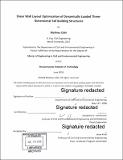Shear wall layout optimization of dynamically loaded three-dimensional tall building structures
Author(s)
Côté, Mathieu, M. Eng. Massachusetts Institute of Technology
DownloadFull printable version (22.27Mb)
Other Contributors
Massachusetts Institute of Technology. Department of Civil and Environmental Engineering.
Advisor
Josephine V. Carstensen.
Terms of use
Metadata
Show full item recordAbstract
Deciding on the appropriate layout of shear walls and the thickness of each member is an iterative process that is time consuming and often leads to suboptimal results. Every time the stiffness of the building is modified, the structural designer must ensure deflection and inter-story drift limits are respected followed by flexural, shear and torsional strength checks for each shear wall. A computational optimization framework has the potential to limit the design time, but most importantly to identify layout configurations with lower costs, weight, embodied carbon and with increased consideration for architectural constraints. Additionally, an optimization framework can provide a strong tool for early stage, pre-conceptual idea exploration and thereby lead to an increased collaboration between architects and engineers. This thesis presents an approach that allows the structural designer to design the shear wall layout of a three-dimensional structure using a linearized modal analysis and a modified genetic algorithm. The presented design scheme uses a ground structure approach as it allows for architectural constraints to be embedded in the design. The objective is defined as a cost function that incorporates material cost and constructability. The proposed framework is used to design the shear wall layout of a building under wind and seismic load cases and is compared to the design obtained with conventional methods. Key terms: Shear wall layout, reinforced concrete, structural optimization, topology optimization, genetic algorithm, dynamic analysis, three-dimensional analysis, cost analysis of lateral systems, tall buildings
Description
Thesis: M. Eng., Massachusetts Institute of Technology, Department of Civil and Environmental Engineering, 2018. Cataloged from PDF version of thesis. Includes bibliographical references (pages 46-47).
Date issued
2018Department
Massachusetts Institute of Technology. Department of Civil and Environmental EngineeringPublisher
Massachusetts Institute of Technology
Keywords
Civil and Environmental Engineering.